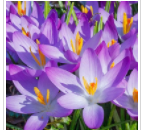Flowering plants, called angiosperms, are absolutely everywhere (even in Antarctica!). They are some of the most successful living things around. But what made them so successful?
Words to know
Cell: a tiny building block that contains all the information necessary for the survival of any plant or animal. It is also the smallest unit of life… more
Cretaceous Period: the geologic time period that lasted from 145 million years ago to 66 million years ago, and that ended with the asteroid strike that is believed to have caused extinction of the dinosaurs….more
DNA (deoxyribonucleic acid): molecular instructions that guide how all living things develop and function…more
Evolution: is any process of growth, change or development over time.
Evolutionary tree: (or phylogenetic tree) a branching structure that shows the evolutionary relationships between different groups of organisms….more
Gymnosperm: a seed-producing plant that doesn’t package its seeds within fruits or flowers….more
What’s in the Story?
Life is competitive. All of the living things you see around you are the result of their ancestors, who successfully competed for food, water and space for millions of years. If I told you that most of the plants on land all come from the same ancestors, you’d think that those ancestors must have done something really well, right? Well, this is the case with the “angiosperms,” a massive group that accounts for 80% of all the plants you see on land. Compared to gymnosperms (needle-covered plants like pine trees), angiosperms just about rule the world.
There are almost 300,000 known species of angiosperms, including all of earth’s fruits, grasses, and flowers. Angiosperms can live in the blistering desert or the frigid Antarctic, and in evolutionary terms, they are still young. Where did these angiosperms come from and how did they spread from a new group of species to one of the most widespread and diverse groups of living things in the world?
In the PLOS Biology article, “Genome Downsizing, Physiological Novelty and the Global Dominance of Flowering Plants,” researchers tried to figure out exactly what made these plants so special.
A Bit of Plant History…
Let’s say you’ve been transported back in time to the “Cretaceous Period.” If you went out walking, you would see mosses, ferns, needle-covered trees, and even some of the first flowers popping up. Flash forward 40 million years and BAM! – flowers are EVERYWHERE and the needle-covered gymnosperms that once covered the land aren’t the most common sight anymore. Instead, we have the big, leafy relatives of our flowering plants: trees that look more like Oaks or Maples.
Okay, I know that 40 million years sounds like a very long time, but it often takes 100s of millions of years for life on earth to change noticeably. For angiosperms, it took less than 50 million years to kick gymnosperms off their prickly throne and become one of the most common forms of life around.
Plants and Plant Food
Living things depend on food for just about everything. Plants need food to grow and to make the seeds that will one day become a whole new plant. Unlike animals though, plants can photosynthesize, or make their own food (sugar) using sunlight and carbon dioxide.
Because this action happens inside of the leaves, plants have openings called stomata to let in carbon dioxide (CO2), kind of the same way that we breathe in through our mouths. After the cells in the leaves make sugars, the sugars are transported around the plant within veins.
Our angiosperm friends have a huge amount of stomata (plural of stoma) and veins which really makes the most of their photosynthesis. These stomata bring in loads of CO2 and the veins move sugars around very easily. This has helped angiosperms grow and spread way faster than other plants and has pretty much led them to world domination!
Why Hasn’t This Happened in Other Plants?
If having more veins and stomata is so helpful, why hasn’t this evolved in other plants? Well, in truth, it’s because all of these structures are made up of cells. If you want more transport methods in a leaf, you need more cells to make them, but that would mean a bigger leaf, which would need even more veins and stomata – see the issue here? It’s a cycle that would usually create bigger plants, unless of course, you find a way to make smaller cells. Angiosperms have small cells that can make a dense network of veins and stomata, like a bunch of side-by-side subway routes! So the next question is, how do you get smaller cells?
You might picture DNA as a tiny little chain, but when you are working within tiny, tiny cells, that DNA can take up a lot of space. The entire code of DNA (an organism’s whole genome) is in almost every one of that organism’s tiny cells. If there was a way to get rid of a bunch of DNA, you can have smaller cells. Smaller cells can leave room for more veins between cells, and for more specialized cell structures, like stomata.
The scientists came to this idea by looking at the genomes of a bunch of plant species (not just angiosperms). They measured which plant species had the smallest genomes and therefore, the least amount of DNA in each cell. Thankfully, they didn’t need to do all these measurements themselves. A lot of information on plant DNA has already been recorded.
How Do You Measure Genome Size?
If we can’t see DNA very easily, how would a scientists be able to measure something like genome size? Well, there are a few ways. They can look at special cell images from powerful microscopes and measure physical size. They can measure the concentration of the amount of phosphate in a counted number of cells, as phosphate is an important part of DNA molecules. Or they can figure out the concentration of a single gene that has been marked with a dye (they can do this by looking at how light is absorbed by a sample with all of those specific genes dyed). These are just a few ways that scientists can measure genome size.
So the scientists from this project gathered together all of this info from other scientists and looked at plant fossils to help them think about angiosperm history. They found that angiosperms were the only group of plants that went through a genome downsize during this period. This is what made them so successful.
Lucky Angiosperms, Lucky Animals
We should be happy that angiosperms are such a common and popular group. We breathe in oxygen and breathe out CO2. Plants do the opposite—they breathe in CO2 and breathe out oxygen during photosynthesis. Because angiosperms photosynthesize so much, they are some of the best oxygen makers around.
So the next time you’re out in nature and you’re wondering who to thank for the colorful scenery, the fresh air and the tasty fruits, you now have your answer. Angiosperms have been so successful because of their compact DNA and cells. Angiosperms – you are one magnificent bunch of plants.
Bibliographic details:
- Article: Angiosperms: A Guide to World Domination
- Author(s): Connor Chato
- Publisher: Arizona State University School of Life Sciences Ask A Biologist
- Site name: ASU – Ask A Biologist
- Date published: May 22, 2018
- Date accessed: September 24, 2021
- Link: https://askabiologist.asu.edu/plosable/angiosperms-success
Learn how to read a scientific article






